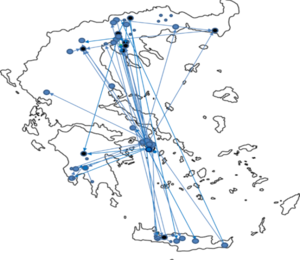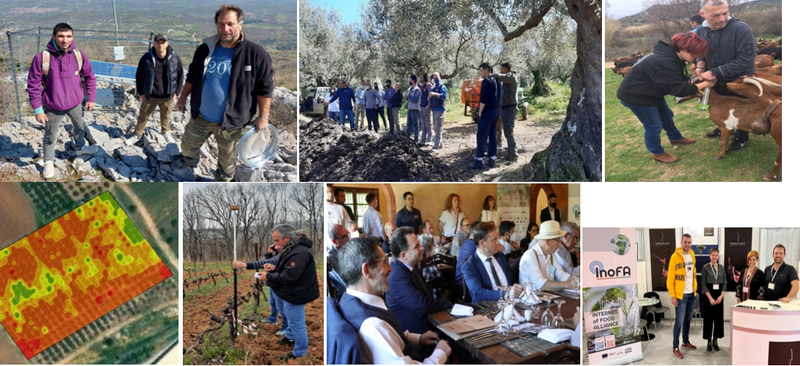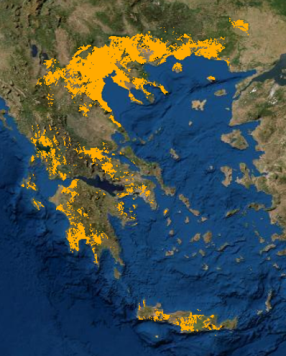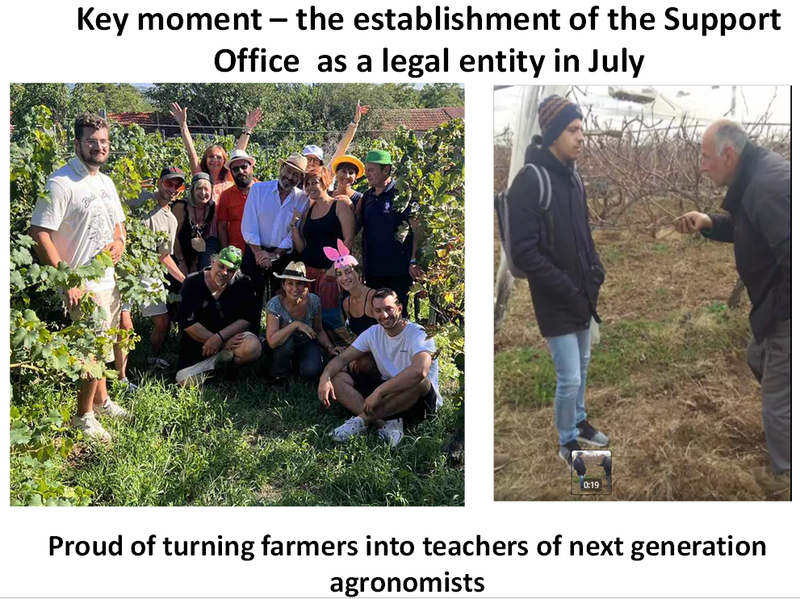Internet of Food Alliance (InoFA) Support Office
Living Lab

InoFA is a vertically integrated, quadruple helix, cluster dedicated to the digitalisation of a sustainable Greek agrofood sector. With over 80 members, InoFA covers geographically the whole of Greece.
Aim
Create a permanent network of real economy players along the supply chain, technology and service providers, RTOs and civil society institutions, with a view to promoting the sustainability of the agrifood sector.
Short history and funding structure
InoFA was created as a project in 2020 with funding by the Greek General Secretariat for Research and Innovation. It designed 11 internal projects, to the total value of 350.000€, engaging a total of 30 of its members, now in the early stages of the implementation phase. In addition, the facilitator organisation was granted 200.000€ for support and coordination activities. Adopting a proactive approach, and with a view to the post-project economic sustainability of the network, the InoFA Support Office was established in July 2022 as a legal entity with its own Registry and BIC numbers.
Activities

Given the European Green Deal, and in order to stay relevant to the needs of the real economy members, it was decided that InoFA should design projects and provide them with tools that minimise the environmental footprint of their activities.
Thus, we engaged them with:
- Biostimulants as an alternative to chemical fertilisers;
- Compostable cover ground covers;
- Utilisation of photonic technologies for yield and quality management;
- Sustainable irrigation;
- Sustainable management of free range bovines, and other innovative practices, as means of surviving the transition period.
At the same time, we make farmers visible by facilitating:
- short supply chains,
- digital traceability and proof of provenance and
- digital marketing.


- The above activities are underpinned by the largest, open, private and rural IoT RoRAWAN network, created by InoFA for the benefit of its members. This network is open for utilisation by farmers inside the coverage area and admits hardware for different technology suppliers who incorporate LoRA telecommunications protocols in their devices. The adoption and utilisation of the digital technology is supported with manuals and short training videos available on YouTube (see below). A help-desk service is available to users with one agronomist and one animal scientist giving them advice on the readings of sensors. All the data are uploaded on a central Microsoft Azure cloud and the robustness of the system is continuously monitored. Local technicians have been trained and are utilized as freelancers for the maintenance and repairs of the infrastructure, thus contributing to the overall digital maturity of rural areas in Greece.
- Looking towards the future, InoFA has identified the significance of training of agronomists and farmers in the use of digital technologies. To that end it participates in the creation of demonstration and piloting farms in collaboration with local Vocational Schools, Universities and Civil Society organisations in Amaliada (Peloponnese – Southern Greece) and Voio (Western Macedonia – Northern Greece).
Methods and tools
Producer-driven innovation is at the heart of InoFA. The issues to be dealt with are identified by the real economy players and their common characteristic is that they have an immediate impact on their economic sustainability. From this starting point, experimenting, piloting and demonstrating in real commercial settings is imperative for the credibility of the proposed solution; this often complicates things, but it is unavoidable. For instance, we are currently negotiating with a Czech Agro-Photo Voltaic supplier the piloting of their solution in different cultivations. In short, InoFA might be the innovation facilitator, but it is the farmers who are the investigators, evaluators and innovation diffusers.
From our experience, the success of innovation facilitation requires the combination (a) of constant, mundane, engagement with intermittent innovation interventions and (b) knowledge transfer with experience exchange with a view to creating a community of practice. These underlying principles dictate more or less the means by which we involve users in the innovation process.
The communication with real economy players is both direct and mediated, through for instance local field agronomists who are their everyday service providers. Communication with such intermediaries is both personal, informal and through occasional organised meetings, both local and interregional. The same applies to communication with farmers; special attention is given in this context to encouraging peer-to-peer exchanges among farmers from different regions.
The Covid-19 crisis had at least one positive side-effect, people became familiarised with e-meetings and conferences; we are now moving to a hybrid system of organised sessions involving specific topics of interest, with three presenters (one researcher, one tech provider and one user) plus a facilitator highlighting local peculiarities, followed by discussion among the audience.
The above types of activities set the innovation agenda and allow InoFA to identify members most likely to become actively engaged. Once a project is underway, the farmers involved are essentially its owners since they undertake all data generating activities with InoFA guidance and support. RTOs are mostly involved in establishing protocols and analysing data. Evaluation of results is jointly undertaken by RTOs and farmers, the latter mostly concerned with impact and economic viability.
While projects are developing, progress is discussed and results disseminated through focus groups and workshops.
Achievements
In the following lines we will provide some concrete examples of impact, ranging from operational efficiency to opening up of opportunities:
- By utilising the digital soil sensors of InoFA, sesame cultivators in Eastern Macedonia/ Thrace have improved the seed germination rate by over 20%, thus making considerable cost savings.
- By regulating irrigation through InoFA installed soil moisture sensors and electronic valves olive and bean cultivators in Western and Central Macedonia have made saving not only on their water usage by 25% but also on fungicides. Irrigation management applications have been developed by InoFA RTOs.
- By using microbial biostimulants in table grape vineyards, in conjunction with digital soil analysis software developed by InoFA RTOs, we have reduced the use of fertilisers by 25%, making savings in the region of 250€ per hectare. In addition, at least one composting facility start up is in the process of being established, thereby producing an import substitution effect (currently most commercial biostimulants are imported from Spain and Serbia).
- By creating interactive maps of the presence of Mediterranean fruit flies in Peloponnese, we alert local farmers on the likelihood of danger for their olive trees; it is hard to assign a financial figure to the impact of this service.
- By using light sensors in the greenhouses in Crete, members are improving their yields and making savings in the replacement of the aging plastic sheets. In addition, the cooperative agronomist is able to provide benchmarked advice to their members regarding their cultivation practices.
- By proactively training InoFA members to measuring their CO2 impact using the “Cool Farm Alliance” tool, we have given them access as suppliers to A.B. Vassilopoulos, the 3rd largest chain in Greece.
- By establishing a digitally supported short supply chain for meat from indigenous bovine breeds in Central and Eastern Macedonia, we have increased the revenues of local farmers by about 0,50€ per kilo, or on average, by 150€ per animal.

Further information and links
- Tutorial CoreIoT Youtube Video
Τεχνολογία Εντοπισμού Ζώων Youtube Video
 tap and then scroll down to the Add to Home Screen command.
tap and then scroll down to the Add to Home Screen command.